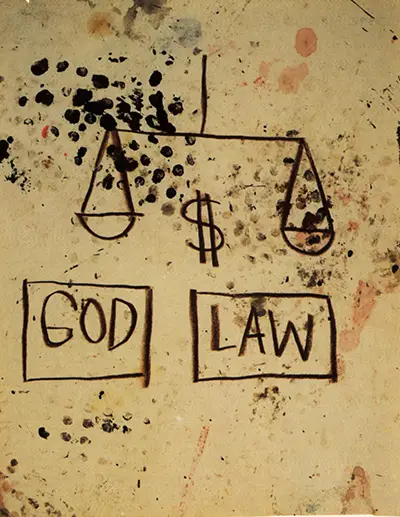Basquiat formed part of the graffiti duo SAMO who painted street art (which often consisted of symbols, epigrams or a combination of words and images) around Manhattan.
Like many of Basquiat's works, 'God, Law' is highly symbolic. It might be compared to his work Tuxedo, for example, which simply depicts a crown. Like the crown, the scales are a time honoured symbol of justice or measurement and Basquiat taps in to this in 'God, Law'.
This gives the art work an archetype quality that can resonate with the viewer on a very deep level. Like much of Basquiat's work it is both simple and profoundly affecting.
The theme of societal inequality is very clear in God, Law. This art work simply features a pair of scales with a the words 'GOD' and 'LAW' written beneath each side of the scales.
The dollar sign sprayed beneath the scales leaves the viewer in no doubt that Basquiat is depicting a corrupt, materialistic world where law and religion are heavily influenced by material wealth.
Basquiat created this symbol by simply drawing on to the paper with a pencil. But, this is probably not a mere preliminary sketch: it is a work of art in its own right. This drawing is executed in street art style and its resemblance to graffiti is a manifest rejection of the 'highbrow' ideals of traditional art. Instead, Basquiat is using this street art medium to critique inequality in the world.
One other interesting thing about this painting is the paper, which is covered with watermarks, splashes and stains. Basquiat may or may not have made these marks himself, but either way they add a sense of dynamism to the work. Basquiat's work often involved 'found materials' like this one - he sprayed symbols onto stained, marked walls and on to pieces of paper that already had print or splashes on.
Basquiat died when he was still in his 20s, in 1988, and he is renowned today as both a street artist and as a neo-expressionist painter.


